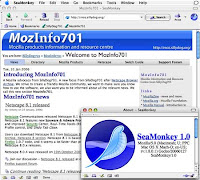

Automatically regenerated whenever XPCOM registration process is triggered. Deleting the chrome.rdf file effectively "uninstalls" all extensions and themes although the files themselves will remain. If found, remove the 'read-only' attribute (or unlock the file on MacOS), as it results in creation of multiple numbered bookmarks-n.html files SeaMonkey 2.0 and below and Mozilla Suiteīookmarks (for SeaMonkey 2.1 and above, see places.sqlite below, and also the about:config prefs and .)

Temporary empty file that signals a change in the installed extensions. *.mab (other than abook.mab and history.mab)Ĭontains subscribe newsgroups for the current server. Index files for mail messages, for example, Inbox.msf (mbox name).msf - in the ImapMail, Mail, and News folders These are text files that contain all of the messages for that folder, for example, Inbox. (mbox name) - in the ImapMail, Mail, and News folders The "(number).s" value is referenced in the about:config preference signon.SignonFileName If you don't see it, make sure you have the "All" button pushed. The console should display the location of the profile that is currently in use.
#SEAMONKEY PLUGIN CODE#
In the Error Console or JavaScript Console window, paste the code in the field near the top. It is one very long line ending in path-make sure that you get all of ).get("ProfD", ).path This is useful, for example, if you are using a profile that is not in the default location given in the above tables.įrom the SeaMonkey menu bar, choose "Tools -> Web Development -> Error Console" (it may be called "JavaScript Console" in some versions). You can use the following technique to find the location of the profile that you are currently using. This section describes how you can find one of these other profiles. When creating a profile with the Profile Manager, you can choose to place it in a location other than the default profile location. ~/Library/Application Support/Mozilla/Profiles//********.slt
#SEAMONKEY PLUGIN WINDOWS#
Windows 95 (with Desktop Update) and Windows 98/Me, alternateĬ:\Windows\Profiles\\Application Data\Mozilla\Profiles\\********.sltĬ:\Winnt\Profiles\\Application Data\Mozilla\Profiles\\********.sltĬ:\Documents and Settings\\Application Data\Mozilla\Profiles\\********.slt

Windows 95 (with Desktop Update) and Windows 98/MeĬ:\Windows\Application Data\Mozilla\Profiles\\********.slt Mozilla Suite and SeaMonkey 1.x profile folder locationĬ:\Windows\Mozilla\Profiles\\********.slt Asterisks ( * ) represent a random string of numbers or letters.

The named profile folder contains the "********.slt" ("salted") folder where the actual profile data is stored. The same profile will also be used if another of these applications is later installed (but sharing a single profile back and forth among applications is not recommended, as it may corrupt the profile). The first time one of these applications is started, a profile named "default" is created. Netscape 7.x, Mozilla Suite and SeaMonkey 1.x all use the same profile folder location and profile registry file ("registry.dat"). You can also use Windows Search to find specific files in your profile folder but on Windows XP and above you must enable searching hidden files and folders in the Search tool itself. You can also navigate to to the profile folder location in Windows Explorer or My Computer but on Windows 2000 and above, you first need to enable viewing hidden files and folders in your Windows Folder Options. You can also specify which folder to open, such as %APPDATA%\Mozilla\SeaMonkey\Profiles\ (SeaMonkey 2) or %APPDATA%\Mozilla\Profiles\ (Mozilla Suite/SeaMonkey 1.x). You can then open successive folders until you get to the profile folder. This will open a Windows Explorer window showing the contents of the "Application Data" folder in Windows 2000/XP or the "AppData\Roaming" folder in Windows Vista and above. Windows Vista/7/8/10: Press "Windows key +R" to open the Run dialog → type %APPDATA% → click OK (Alternatively, press the Windows key to open the Start menu, type %APPDATA% in the search box and press the enter key.).Windows 2000/XP: Click Start → Click Run → Type in: %APPDATA% → click OK.To quickly find your profile folder, you can use the %APPDATA% environment variable as follows:


 0 kommentar(er)
0 kommentar(er)
